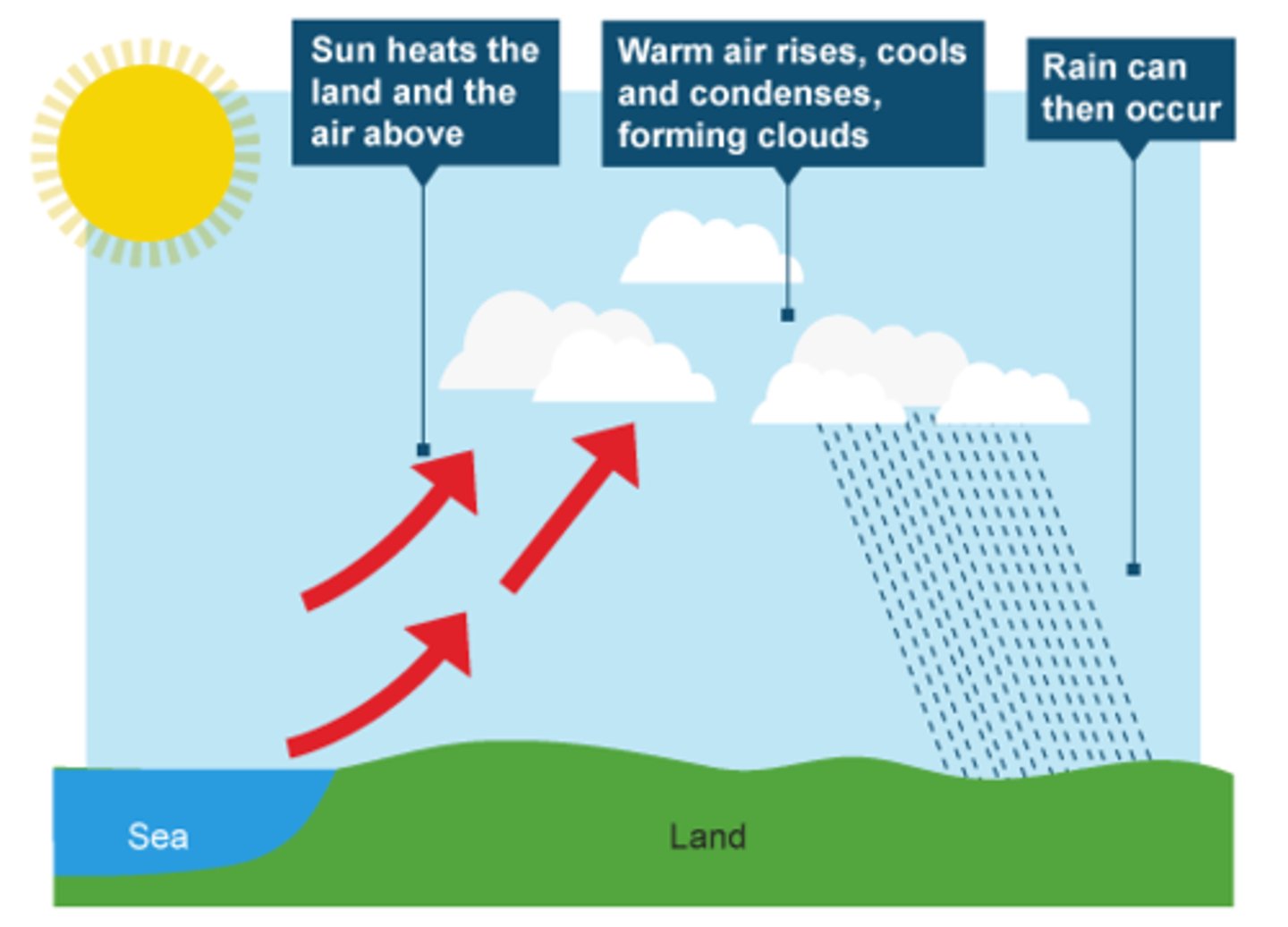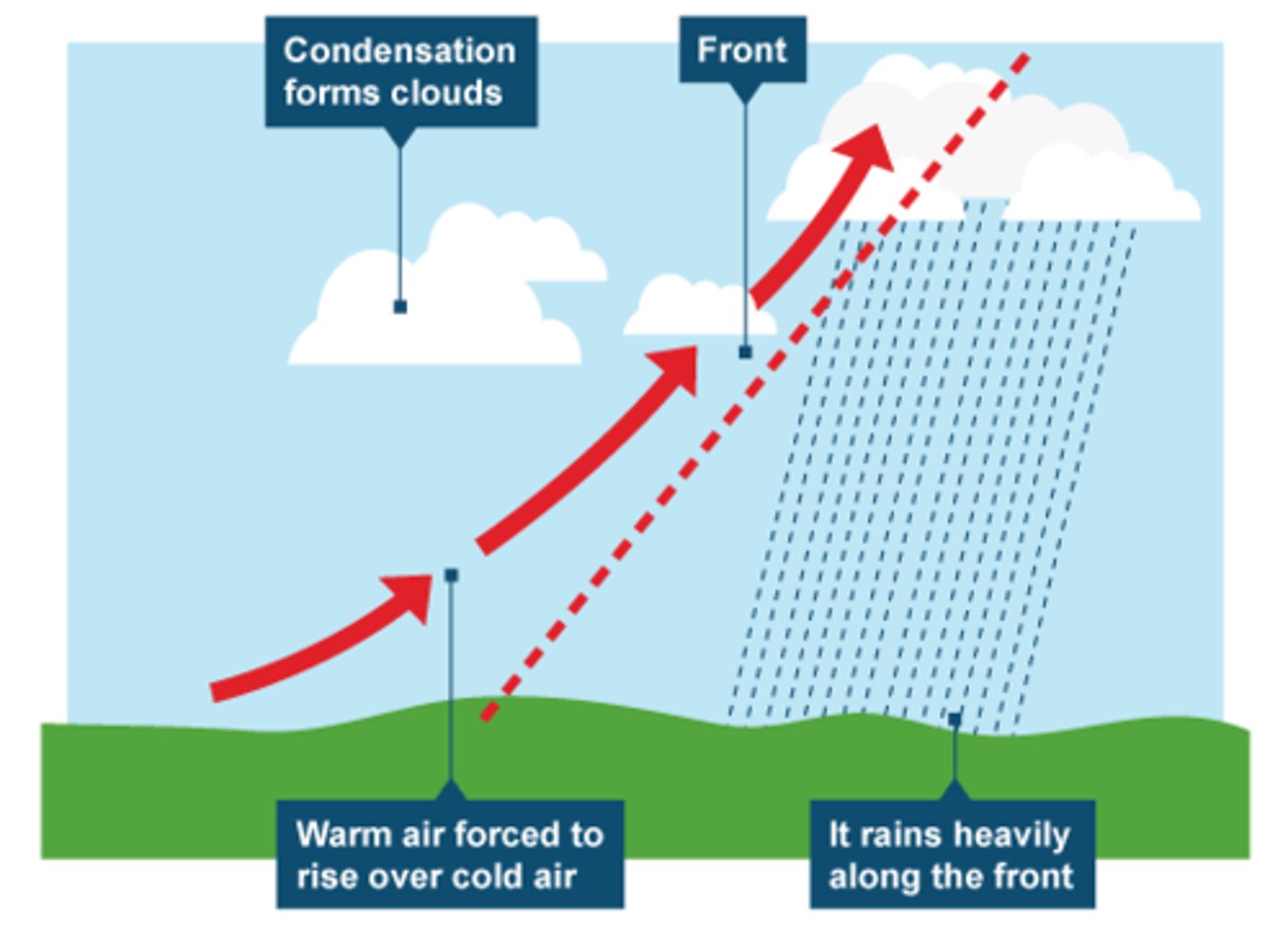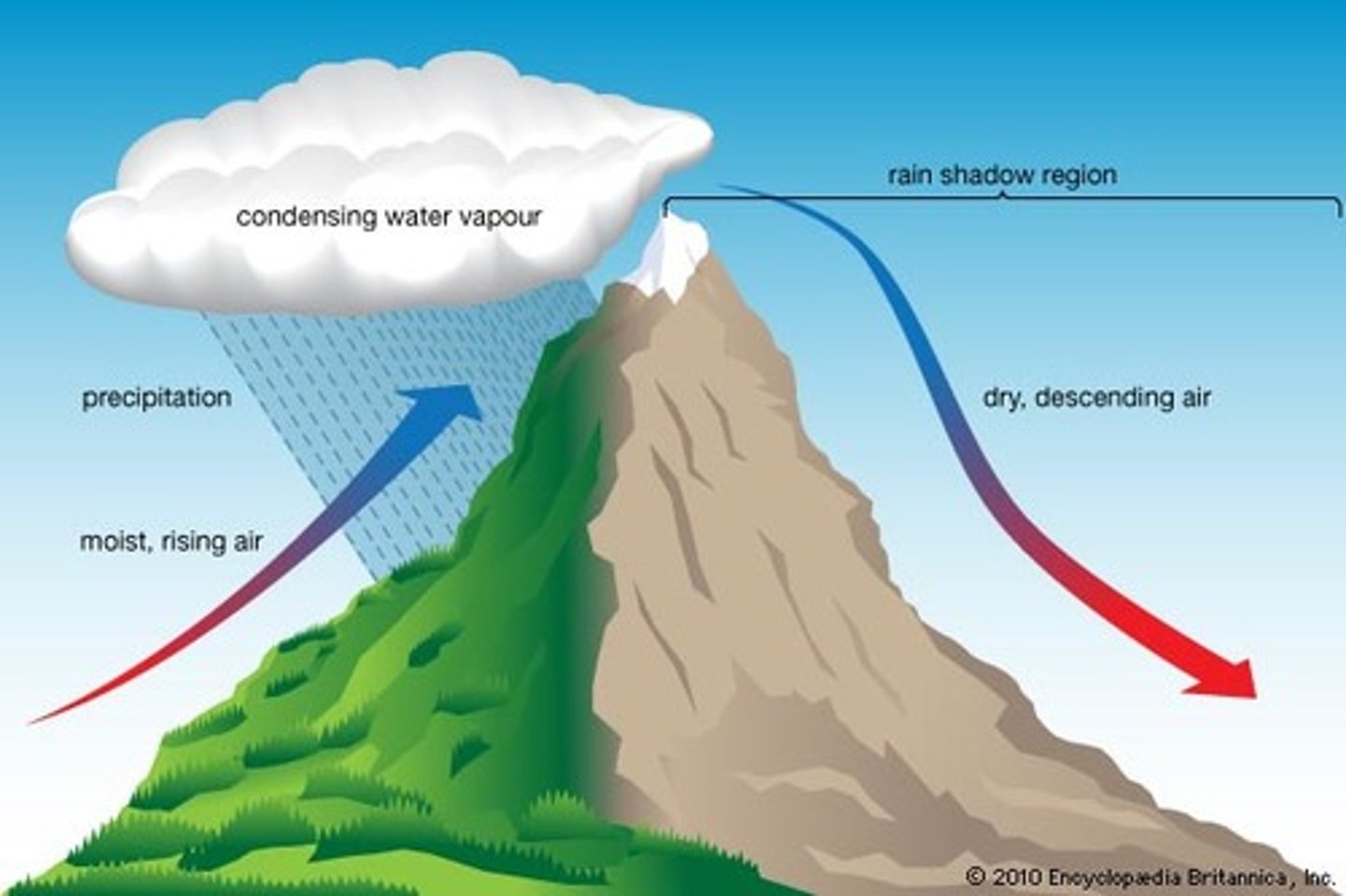Edexcel A-level Geography - Water cycle
1/304
There's no tags or description
Looks like no tags are added yet.
Name | Mastery | Learn | Test | Matching | Spaced |
|---|
No study sessions yet.
305 Terms
Global Hydrological Cycle
Circulation of water around the earth
How is the Global Hydrological Cycle a closed system?
No external inputs or outputs.
The amount of global water is finite and constant.
Open system
Receives inputs from and transfers outputs of energy and matter to other systems
Sources that drive the Global Hydrological Cycle (2)
Solar energy (in the form of heat)
Gravitational Potential Energy (precipitation falls to the floor/ rivers flow downhill)
What are the stores of the water cycle? (6)
Ocean
Atmosphere
Biosphere
Cryosphere
Groundwater
Surface water
Flows
Transfers of water from one store to another (km^3 per year)
Fluxes
Rates of flow between stores
Flux size of flow of precipitation
486,000 km³/year
Global Water Budget
Takes into account all the water that is held in stores and flows of the global hydrological cycle.
Residence Time
Average time a molecule of water will spend in one of the stores.
Atmosphere Residence Time
10 days
Ocean Residence Time
3,600 years
Ice Cap Residence Time
15,000 years
What is blue water?
Water stored in rivers, streams, lakes and groundwater in liquid form - visible part of the hydrological cycle
What is green water?
Water stored in the soil and vegetation - invisible part of the hydrological cycle
What is grey water?
Relatively clean water waste from baths, sinks and kitchen appliances
What is groundwater?
The water held within permeable rocks (aka aquifer)
What is the cryosphere?
Areas of the earth where water is frozen into snow or ice
What is fossil water?
Ancient, deep groundwater from former pluvial (wetter) periods
What is the biosphere?
The regions of the earths surface and atmosphere occupied by living organisms
What is evaporation?
The change in state of water from a liquid to a gas
What is transpiration?
The diffusion of water from vegetation into the atmosphere, involving a change from a liquid to a gas
What is precipitation?
The movement of water in any form from the atmosphere to the ground
What are flows in the hydrological cycle?
The physical mechanisms that drive the fluxes of water between the stores
Oceans water store
97%
How much of global water is available for humans to use?
3%
Easily Accessible surface water store
1%
What are the three conditions needed for precipitation to form?
Air cooled to saturation point with a relative humidity of 100%
Condensation nuclei, such as dust particles, to facilitate the growth of droplets in clouds
A temperature below dew point
What is dew point?
The temperature at which dew forms - it is a measure of atmospheric pressure
What are condensation nuclei?
Particles in the atmosphere on which droplets of water vapour can collect
Inputs into the global hydrological cycle
Main Input = Precipiation
How can form of inputs have effects on the hydrological cycle?
Precipitation can occur as rain, snow or hail
With snow, entry of water into the drainage system will be delayed.
How can amount of inputs have effects on the hydrological cycle?
This will affect the amount of water in the drainage basin and the fluxes within it.
How can intensity of inputs have effects on the hydrological cycle?
The greater the intensity, the greater the likelihood of flooding.
How can seasonality of inputs have effects on the hydrological cycle?
This is likely to result in the drainage basin system operating at different flow levels at different times of the year.
How can distribution of inputs have effects on the hydrological cycle?
This is significant in very large drainage basins, such as the Nile and the Ganges, where tributaries start in different climate zones.
Flows (7)
Interception
Infiltration
Percolation
Through-flow
Groundwater
Surface Runoff
River/Channel Flow
Interception
The retention of water by plants which is subsequently evaporated or absorbed by the plant
Infiltration
The process by which water soaks into, or is absorbed by, the soil
Percolation
The slow movement of water underground through permeable rock
Throughflow
The lateral transfer of water downslope through the soil
Surface Runoff
The movement of water that is unconfined by a channel across the surface of the ground
River/Channel Flow
The flow of water in rivers or streams
What are percolines
Lines of concentrated water flow between soil horizons to the river channel
What is infiltration capacity?
The maximum rate at which rain can be absorbed by the soil
Types of Rainfall (3)
Convectional
Relief
Frontal
Convectional rainfall
When the ground warms up, evaporation takes place and the heated air rises and then it cools and condenses to form clouds
The rainfall created is often intense and associated with electrical storms and thunder

Frontal rainfall
Formed when warmer moist air meets colder polar air
The warmer air is forced to rise over the denser, colder air, creating low pressure and rain

Orographic rainfall
When warm, moist air is forced to rise over upland areas, causing moisture to condense and create rainfall

What is rain shadow?
A dry area on the downwind side of a mountain.
How do rain shadows form?
When orographic rainfall has occurred over an upland area, the area on the lee side of the hills will receive less rain because the air descends, warms and becomes drier
What are jet streams?
Bands of fast-moving air which determines the direction of weather systems and their speed of movement
Altitude of jet streams
9-16km
Outputs of the Global Hydrological Cycle (3)
Evaporation
Transpiration
Discharge
Outputs of the Global Hydrological Cycle - Evaporation
The process by which moisture is lost directly into the atmosphere from water surfaces, soil and rock.
Outputs of the Global Hydrological Cycle - Transpiration
The biological process by which water is lost from plants through minute pores and transferred to the atmosphere.
Outputs of the Global Hydrological Cycle - Discharge
Flows into another, larger drainage basin, a lake or the sea.
Evapotranspiration
Total amount of water removed from a drainage basin from liquid water to gas and water in the soil taken through plants that is e from the stomata
Drainage Basin
Area drained by a river and its tributaries
Watershed
An elevated area of land that divides and separates neighbouring drainage basins
What are the physical factors affecting drainage basins? (5)
Climate, soils, vegetation, geology, relief
How does climate affect drainage basins?
Impacts inputs and outputs; has a role in influencing the type and amount of precipitation and overall amount of evaporation
How do soils affect drainage basins?
Affect surface runoff; determine the amount of infiltration and throughflow
How does geology affect Drainage Basins?
Geology can impact on subsurface processes such as percolation and groundwater flow
How does relief affect Drainage Basins?
Slopes can affect the amount of runoff
How does vegetation affect Drainage Basins?
The presence or absence of vegetation has a major impact on the amount of interception, infiltration and occurrence of overland flow, as well as transpiration rates
Human Factors Disrupting the Drainage Basin Cycle (3)
River Management, Deforestation, Changing Land Use (Agriculture and Urbanisation), Resevoirs
Human impacts on drainage basin - river management
Construction of storage reservoirs holds back river flows
Abstraction of water for domestic flow and industrial use reduces river flows
Abstraction of groundwater for irrigation lowers water tables
Human impacts on drainage basin - deforestation
Clearance of trees reduces evapotranspiration, but increases infiltration and surface runoff
Human impacts on drainage basin - changing land use: agriculture
Arable to pastoral = Compaction of soil by livestock increases overland flow
Pastoral to arable = Ploughing increases infiltration by loosening and aerating the soil
Human impacts on drainage basin - changing land use: urbanisation
Urban surfaces (tarmac, tiles, concrete) have increased surface runoff by reducing percolation and infiltration
Drains deliver rainfall more quickly to streams and rivers, increasing chances of flooding.
Human impacts on drainage basin - reservoirs
Reservoirs hold back the flow of water and create new surface stores
Water Budget
Annual balance between inputs and outputs of the water system.
Water Budget Equation
Precipitation = EVT + Runoff +/- Storage
How are water budgets useful on a national/regional scale?
Give an indication of the amount of water that is available for human use (for agriculture, domestic consumption etc.)
How are water budgets useful on local scales?
Inform about available soil water.
This is the amount of water that can be stored in the soil and is available for growing crops.
Valuable to farmers, who can use it to identify when irrigation might be required, and how much is required.
What is potential evapotranspiration?
The water loss that would occur if there was an unlimited supply of water in the soil for use by vegetation
What is evapotranspiration?
The combined effect of evaporation and transpiration
What is a water surplus?
Precipitation > evapotranspiration
What is a water deficit?
Evapotranspiration > precipitation
River Regime
Annual variation in the discharge or flow of a river at a particular point.
What are river regimes measured in?
Measured in cumecs.
What are simple river regimes?
Where the river experiences periods of seasonally high discharge, followed by low discharge
Example of simple river regime?
Rhone
What is a complex river regime?
Where larger rivers cross several different relief and climatic zones, therefore experiencing the effects of different seasonal climatic events
Example of complex river regime?
Mississippi, Ganges
What are the ways in which precipitation can vary?
Type, amount, intensity, seasonality, distribution
Ways precipitation can vary - type
Rain, snow or hail
Snow can act as a temporary store, delays input of water
Ways precipitation can vary - amount
Has a direct impact on drainage discharge - the higher the amount, the less variability
Ways precipitation can vary - seasonality
Different climates due to seasonal changes have different amounts of rainfall having an impact on the physical processes in the drainage basin
What is cloud seeding?
A type of weather modification that aims to change the amount/type of precipitation that falls from clouds
How does cloud seeding work?
By dispersing substances into the air from aircrafts that serve as condensation nuclei
What substances are used in cloud seeding?
Dry ice, silver iodide, sodium chloride
Example of a place that used cloud seeding - Beijing
Beijing prevented precipitation so the 2008 Olympics had clear skies for the opening ceremony
Example of a place that used cloud seeding - Idaho
Idaho Power injects silver iodide into clouds to increase snowfall so when it melts in summer there's a lot of runoff
Benefits of cloud seeding
More precipitation benefits hydropower companies
Wineries use it to protect their vineyards from damage by suppressing hail
Insurance companies (e.g. in Alberta) fund cloud seeding projects to lessen damage claims
Negatives of cloud seeding
Expensive
Unknown long term impact
Use of potentially harmful chemicals
Perennial Channel
River with continual flow all year
Intermittent Channel
River with lack of flow for a few weeks/months a year
Ephemeral Channel
River that only flows for a few hours/days (Wadi)